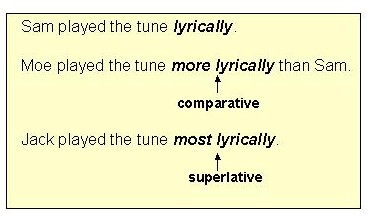ADVERBS
Adverbs are traditionally defined as words that describe verbs.
|
Adverbs answer any of the following questions about verbs: |
|
how? when? where? why? |
|
The following examples illustrate adverbs modifying verbs: |
|
|
|
|
|
How did he lift the barbell? |
|
Easily is an adverb. |
|
|
|
|
|
When will we use it? |
|
Tomorrow functions as an adverb. |
|
|
|
|
|
Where did she hide the key? |
|
Nearby is an adverb. |
|
Adverbs are the most moveable of all parts of speech; therefore, it is sometimes difficult to identify an adverb on the basis of its position in a sentence. |
|
|
|
For example, the adverb slowly will fit into three places in the sentence He climbed the ladder: |

|
Most adverbs end in -ly. In fact, most adverbs are formed by adding -ly to adjectives: |
|
|
|
Like adjectives of more than one syllable, adverbs usually become comparative and superlative by using more and most. |
|
Examples: |

Flat adverbs
Adjectives that do not change form (add -ly) to become adverbs are called "flat adverbs."
Typical flat adverbs are early, late, hard, fast, long, high, low, deep, near.
|
To determine whether these words are functioning as adjectives or adverbs, one must determine |
|
|
|
1) what the word is describing (noun or verb) |
|
2) what question the word is answering |
|
The following examples illustrate the distinction. |
|
|
|
Early as adjective: |
|
|
|
Early describes the noun train and answers the question "which one?" |
|
|
|
Early as adverb: |
|
|
|
Early describes the verb arrived and answers the question "when?" |
|
|
|
Hard as adjective: |
|
|
|
Hard describes the noun pass and answers the question "what kind?" |
|
|
|
Hard as adverb: |
|
|
|
Hard describes the verb threw and answers the question "how?" |

